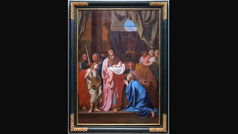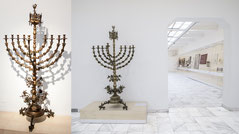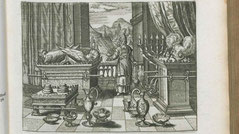ANCIENT AND NEW MENORAHS - 17th Century
This website shows historic menorahs from the seventeenth century. Menorah illustrations from other centuries: Ancient Menorahs until the 1st century, 2nd century, 3rd century, 4th century, 5th century, 6th-10th century, 11th-13th century, 14th century, 15th century, 16th century, 18th century, 19th century, 20th century, 21st century. Coins

17th century. Jewish Gilt Menorah Pendant. A silver pendant comprising a tubular container with drum-shaped lid to each end, loop with raised edges, appliqué disc with ropework border and menorah image. 4.85 grams, 30 mm (1 1/4"). Property of a South West London gentleman; acquired by his father in the 1970s. (The Saleroom, auction, Lot 628). Source: Link1, Link2

17th century. Kashrut seal made of soft metal, tin-pewter. Round. Over the hundreds of years its rim was slightly blemished. About 1.8 cm. wide. A seven-stemmed menorah protrudes from its center. Clearly visible are the three left stems, the middle stems and the beginning of the three right stems. From an American collection of ancient seals and metals from previous centuries. Apparently used by one of the first Jewish American communities. winners-auctions No. 087. Source: Link

17th century. Post Medieval Tin Bronze Menorah/Tree of Life Ring. Origin: Europe. Materials: tin bronze. Size: D 23 mm. Place of discovery: Ukraine. Liveauctioneers, Lot 0084, 2018. Source: Link
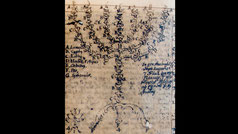
17th century. Fray Juan Ricci (1600–1681), sketch of the menorah as described in Exodus. Fray was a Spanish painter of the Baroque period. He painted several works in Madrid and in Italy (Monte Cassino). Biblioteca Statale del Monumento Nazionale di Monte Cassino, cod. 469, fol. 199v. Source: Link

1601-1700. Title: Śefat ha-ʾEmet: Commentary on the Pentateuch. Creator: Ḳirimi, Avraham [author]. Shelfmark: MS. Oppenheim Add. fol. 45. Folio/page: 106r. Polonsky Foundation Digitization Project. Rights: Photo: © Bodleian Libraries, University of Oxford. Source: Link

1609. Yosef Da'at, Joseph ben Issachar Baer, Prague: Gershom ben Bezalel Katz, 150 leaves (6 5/8 x 5 1/2 in.; 170 x 140 mm). Complete as issued with original error in foliation [1-60 (2), 65-152], title and book divisions within woodcut frames, running title flanked by printer's ornaments, numerous illustrations including a double-page illustration between ff. 60 and 65 as well as several full page illustrations. Sotheby's Auction 19.12.2007, Lot 145. Source: Link1, Link2

1610. Geneva Bible. "Imprinted at London: by Robert Barker, Printer to the Kings most Excellent Maiestie." Title: "The Bible: that is, the Holy Scriptures conteined in the Old and New Testament. Translated according to the Hebrew and Greeke, and conferred with the best translations in diuers languages." This Menorah illustration is in the book Exodus (Bible). University of Glasgow Library. Early English Books Online, No. 2210 . Source: Link

1611. Lighting the menorah. Minhagim from Prague. "Vil hoypshr den di ersṭn zayn geṿezn, daz ṿerṭ man ṿol merḳn am lezn ; fun ale minhagîm in Ashkenaz durkh daz gants yor ..." Author: Tirna, Yitshak Aizik. This menorah has seven lights, not eight, like the later versions. Universitätsbibliothek Erlangen-Nürnberg (Shelfmark: H61/WAGENSEIL.VK 197), Germany. Source: Link
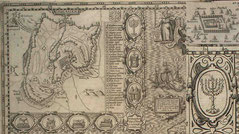
1611. King James Bible (KJV). Map of Jerusalem inset in a Map of Canaan. This map shows two Menorah images with different appearance. However, it can be clearly seen that the 22 almond blossoms were at least sketched out. Creator: Mare, John (Cartographer), Speede, John (Cartographer). Reddit and Cornell University Library, Rare and Manuscript Collections, Identifier: U0250_0102. Source: Link1, Link2, Link3

1611. Illustrated Geneva Holy Bible, printed by Robert Barker, London. The Geneva Bible was the “Bible of the Protestant Reformation”, and the Bible of the Puritans and Pilgrims (“Breeches Bible”). It was the first Bible taken to America, brought over on the Mayflower. The Geneva Bible is the Bible upon which America was founded. First printed in 1560, produced by John Calvin, John Knox, Myles Coverdale, John Foxe, & other English refugees in ever-neutral Geneva, Switzerland. Source: Link1, Link2

1612-1620 (?). Title: Tavnit ha-mishkan: Ḥanukat ha-bayit. Author: Ashkenazi, Malkiel. Origin: Modena, Italy. A work in 2 volumes: the first is on the building of the Tabernacle in the desert; the second is on the Temple in Jerusalem and its holy vessels. The first volume has some marginal notes; the second volume has abundant marginal notes. Library at the Herbert D. Katz Center for Advanced Judaic Studies University of Pennsylvania CAJS Rar Ms 460. Source: Link1, Link2, Link3, Link4

1613. Czech Bible. Title: "Biblia Veteris et Novi testamenti, Bible Adama z Veleslavína." Place of origin: Prague (Praha, Staré Město pražské). Author: Jan Campanus Vodňanský. Printer, publisher: Samuel Adam z Veleslavína. Repository: National Library of the Czech Republic (Národní knihovna České republiky). Shelf-mark: 54.A.6 and 54.A.9 Source: Link

1614. German Luther Bible. Printed in Straßburg by Zetzner. Title: "Biblia, Das ist: Die gantze heylige Schrifft Teutsch : Nicht allein in gewisse Verß abgetheilt Sondern auch mit newen Lehrhafften Summarien, vnd schönen Figuren gezieret." BSB, Augsburg, Staats- und Stadtbibliothek, Th B VII 51f. Source: Link1, Link2
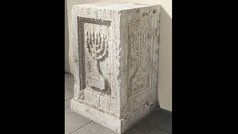
1614. Element of the pope Paul V fountain in the Rome ghetto. Seven-armed menorah. Sculpted Travertine Roma. Jewish Museum in Rome, Museo Ebraico di Roma. Source: Link

1614-1619. Entrance door, India. Zecharia's vision (Zech. 4:2-3) is a common subject decorating artifacts and synagogues, originating in South India. The early depiction of the subject is adorning the Chenemangalam synagogue entrance, built in 1619. This depiction served as a model to later representations. Source: Link1, Link2

17th century. "Collection of three Kabbalistic treatises" (French: "Recueil de trois traités kabbalistiques"). Folio 174: Drawing of a candlestick with 7 branches. Language: Hebrew. Material: Paper. Bibliothèque nationale de France, Département des Manuscrits, Hébreu 858. Source: Link

17th-18th century. Manuscript, Sefer “Etz Chaim”, Kabbalistic commentary on the Rambam’s Sefer HaMitzvot, by Kabbalist Rabbi Yehuda Ibn Chanin. End of volume contains passages from preface of Rabbi Yehuda Ibn Chanin to his book “Sefer HaOhr”. The divine Kabbalist Rabbi Yehuda son of Rabbi Ya’akov ben Chanin (c. 1540-1615), among greatest Kabbalists of Morocco and Algeria, resided in village of Akka [southwestern Morocco]. Kedem Acutions, Los-Nr. 277. Source: Link1, Link2

1621. Map of Palestine. Print maker: Nicolaes van Geelkercken; Italy, Amsterdam (NL). Inscriptions relating to the events of the OT and NT. From left to right: the apostle Peter, the Ark of the Covenant, the Apostle Andreas, a sacrifice table with bread, the apostle John, Menorah, tabernacle cloth... Source: Link1, Link2

1621. German Catholic Bible from Johan Dietenberger. Printed in Cologne as a counter-book to replace the Luther Bible. The first edition of the Dietenberger Bible was published in Mainz in 1534; this was the first Catholic full-bible with the NT and OT. Source: Link

1625. Illustrations about biblical scenes with German texts. Title: "Novae sacrorum bibliorum figurae : versibus latinus & germanicis expositae : das ist neue biblische Figuren mit latinischen und teutschen Versen aussgelegt..." Gloner, Samuel [1598-1642] ; Murer, Christoph [1558-1614] Printed in Strassburg (Germany at that time, now France) by Christoff von der Heyden. Zentralbibliothek Zürich (Switzerland), 7.324. Source: Link

1625-26. Nicolas Poussin: The Destruction and Sack of the Temple of Jerusalem. Oil on canvas. Nicolas Poussin (1594-1665) was a French painter in the classical style. This work was commissioned by his patron Cardinal Francesco Barberini and offered as a gift to Cardinal Richelieu, the French head of state. Photo © The Israel Museum, Jerusalem. Source: Link1, Link2, Link3

1625-1630. "Icones Biblicae: praecipuas Sacrae Scripturae historias eleganter & graphice repraesentantes = Biblische Figuren darinnen die fürnembsten Historien in heiliger göttlicher Schrifft begriffen..." The engravings of Matthaeus Merian (1593-1650) were also used in the Luther Bible, later also in Catholic Bibles (for example, by Ulenberg). Printed in Strassburg (Germany at that time, now France) by Lazarus Zetzners Erben. Language: German, Latin. Zentralb. Zürich, Rv 76. Link, Link2, Link3

1630. German Luther Bible with magnificent Illustrations from Matthaeus Merian. Printed in Straßburg (Germany at that time, now France) by Zetzners Erben. Title: "Biblia, Das ist, Die gantze H[eilige] Schrifft Alten und Newen Testaments, Verteutscht: Durch D. Martin Luther..." The text is from Luther's last edition of 1545. Univ.-Bibliothek Frankfurt am Main, Signature: Ausst. 303. Source: Link1, Link2
Black and white image: Link3

1631. Engravings with biblical scenes without text. Title: "Icones Biblicae : Praecipuas Sacrae Scripturae Historias eleganter et graphicae repraesentantes" Printed in Köln (Cöllen, Germany) by Johann Krebs. Halle, Saale: Universitäts- und Landesbibliothek Sachsen-Anhalt, 2017. Source: Link

1632. This beautiful menorah figure is a section of an extraordinary c. 1632 map of the Holy Land by the Jesuit monk Jacobus Tirinus. Surrounding the map proper on the left, right, and bottom margins, there are 19 maps and images of Biblical objects (Menorah, Ark of the Covenant...). Source: Link
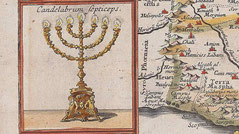
1632. Map of the Holy Land and Jerusalem. Title: "Chorographia Terrae Sanctae in angustiorem formam redacta et ex variis auctoribus a multis erroribus expurgata." Alternative title: "Hierosolymae veteris imago." Includes plan of the Temple in the left bottom corner and view of the Temple in the right bottom corner. Inset: oval map of ancient Jerusalem, Along sides and bottom: 16 vignettes of biblical objects with menorah on the left side. Beinecke Library. Source: Link1, Link2

1633. Danish Bible. Title: Biblia...: det er, Den gantske hellige Scrifft, paa danske igien offuerseet oc prented effter vor... kongis K. Christian den IV. befaling." Printed in Copenhagen (Kiøbenhaffn). German woodcuts were used in several European countries, including Denmark. Bayerische Staatsbibliothek (Germany), Shelfmark: 2 B.rel. 50 e. Source: Link1, Link2

1635. "De triomfboog van Isabella Clara Eugenia opgesteld in de Clarenstraat". The triumphal arch of Isabella Clara Eugenia (1566-1633) drawn up in the Clarenstraat. A central idea of the appointment of Ferdinand as governor of the Netherlands by Philip IV (1605-1665). Print maker: Theodoor van Thulden; design by: Peter Paul Rubens; writer: Casper Gevartius; publisher: Theodoor van Thulden; provider of privilege: Philip IV (King of Spain). Source: Link1, Link2

1636-1649. “The Annunciation to Zacharias” (ital.: Annuncio a S. Zaccaria dalla serie con storie di S. Giovanni Battista) by Andrea Sacchi (1599 - 1661); Hanukkah lamp. This picture shows a small part of the whole painting. Photo: Jewish Museum of Rome; Sacchi painting: Vatican Museum). Surce: Link1, Link2

1638-1639. Nicolas Poussin: The Destruction of the Temple at Jerusalem by Titus or: The Capture of Jerusalem. Oil on canvas. Inscribed "Ni Pussin Fec" on the second shield from the right. Commissioned by Barberini to be given to the ambassador of the Holy Roman Empire in 1639. Dimensions: 147 x 198 cm. Location: Vienna, Kunsthistorisches Museum. Source: Link1, Link2

1640-1713. Drawn by: Carlo Maratti. Basso relief of the Triumph of Vespasian from the Arch of Titus in Rome, 1645; with a procession of figures carrying various objects including a menorah. Black chalk. Inscribed on the old mount in the hand of the English commentator John Evelyn (1620-1706), in brown ink, in the lower centre: "This Bassrelievo of Titus Vispatians Triumphal Arch / neere the Amphitheater at Rome..." Dimensions: Height: 225 mm, Width: 415 mm. The British Museum. Source: Link

1640-1702. Shows one hundred years of Augsburg (Germany) religious creed. The Menorah is decorated with 22 medallions with biblical performances. Above the Holy Spirit. At the bottom left is Frederick III the Wise de Wijze, Elector of Saxony, and right-hand Martin Luther. Printed in Amsterdam. Source: Link

1642. "Blad met Triomfoptocht met de zevenarmige kandelaar en Romeinse munten", Antwerp. Triumphal journey with the Menorah and other treasures from the temple of Jerusalem by Romans, after the destruction of the temple by Emperor Titus. Transport to the relief on the Triumphal Arch of Titus in Rome. print maker: Theodoor van Thulden; after design by: Peter Paul Rubens (mentioned on object). Source: Link1, Link2

1644. German Martin Luther Bible "Biblia Das ist, Die gantze H. Schrifft". Printed in Basel (Switzerland) by Ludwig König Erben Offizin. Staatsbibliothek zu Berlin - Preußischer Kulturbesitz, Germany (Shelfmark 2" Bu 9695). Source: Link

1644. Title: English: Presentation in the Temple; Français: Présentation de Jésus au Temple. Artist: Sébastien Bourdon (1616–1671). Medium: Oil on canvas. Dimensions: Height: 71 cm (28 in). Width: 61 cm (24 in). Current location: Louvre Museum. Wikipedia. Source: Link

1645-1646. "Salomo bidt om wijsheid." Solomon kneels before the ark of the covenant with the seven-armed candlestick (menorah) and asks God for wisdom. The print is part of an album. Artist: Print maker: Christoffel van Sichem (II) (mentioned on object), print maker: Christoffel van Sichem (III) (mentioned on object), Veit Rudolf Specklin, Hans Holbein (II). Publisher: Pieter Jacobsz Paets. Place: Amsterdam. ize: h 106 mm × w 85 mm. Source: Link1, Link2, Link3

1645-46. Ark of the covenant and objects from the tabernacle (Ark van het verbond en voorwerpen uit de tabernakel). Ark of the covenant, in which tablets of the law are kept. Above that, two cherubs. On the right is a menorah. Thereby crockery for the wine offerings and a table with the showbread. Left Aaron in priestly robes. The print is part of an album. Print maker: Christoffel van Sichem (II) and Christoffel van Sichem (III), after print by: Veit Rudolf Specklin, designed by: Hans Holbein (II). Link1, Link2

17th century. The circumcision (Die Beschneidung) by Johann Jakob Söntgens (d. 1701). Dimensions: 41 x 55.1 cm. Rheinisches Bildarchiv Köln. Köln, Wallraf-Richartz-Museum, Inv.-Nr. Z 311 & 1929/3. Source: Link

17th century. Marriage of the Virgin by Unknown Emilian artist, oil on canvas, about 1650 (?). Oil on canvas, 74x99 cm. (Inv. 843). Copyright Veneranda Biblioteca Ambrosiana. (Photo By DEA / VENERANDA BIBLIOTECA AMBROSIANA / De Agostini, Getty Images). Source: Link

1649. Yehudah ben Shemuʾel Reutlingen Mehler from Fulda, Germany: Sefer ʿIbronot. Staatsbibliothek zu Berlin - Preußischer Kulturbesitz. Source: Link

1650-1651 (5411). Lighting the menorah. Title: Maḥzor for the entire year, Western-Ashkenazi rite (Worms, Germany). Content: Festival prayer book for the festivals and the Special Sabbaths. Title: Maḥzor minhag Ashkenaz ha-Maʻaravi (Ṿormaiza) le-khol ha-shanah. Languages: Hebrew, Yiddish. BL-UK Or 10641. The National Library of Israel. Source: Link1, Link2
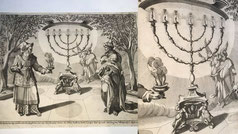
1650-1699. Title of artwork: "Judaica - Chandelier a sept branches Synagogue époque Villalpandus XVIIme siècle Gravure de l'époque." Engraving. Dimensions: Height: 30cm, width: 40cm. Catawiki. Source: Link

1650. Antique Map of The Holy Land, Palestine, Israel. Cartographer: Jacobus Tirinus. This large magnificent, hand colored original antique map by Johann Belling & Augustus Vindel was published in Commentarius in Sacram Scripturam by the Belgian Jesuit monk Jacobus Tirinus. Source: Link

1652-1708. Printer: Anonymous. Antique map of Jerusalem's Temple Mount from the east and the temple equipment. In the midst of the temple at Solomon's temple, the table for the showbread, the menorah, in a niche, a statue of Aaron the high priest, the tabernacle, a golden basin... Source: Link

1654. Title: "Retrato del Tabernaculo de Moseh: en que se descrive la hechura del S. Tabernaculo que Moséh hizo antiguamente en el desiérto ... / por el H. Jaacob Jeuda, Leon Hebreo ..." Author: León Hebreo. Printed in Amsterdam: Gillis Joosten. Biblioteca Digital Hispanica, Signatura U/3732. Source: Link1

1656. German Luther Bible. Title: "Biblia, Das ist/ Die gantze H: Schrifft, Altes und Neues Testaments, Teutsch". Printed in Nuremberg, Printer: Endter. VD17-Digitalisierung der HAAB Weimar, Signature: 19 B 3136. Source: Link

1657. Dutch Bible. Title: "Biblia Sacra Dat Is De Geheele Heylighe Schrifture Bedeylt in't Out en Nieu Testament. Oversien en verbetert na den lesten Roomschen text. Verciert met veele schoone figueren [gesneden door Christoffel van Sichem] Eerst T'Antwerpen by Ian Van Moerentorf En Nu Herdruckt." Illustrator: Christoffel van Sichem. Printed in Antwerpen (Paets). Universitätsbibliothek Erlangen-Nürnberg. Source: Link

1657. Biblia Sacra polyglotta, complectentia textus originales. Author: Walton, Brian (1600-1661). Ark, Lampstand, Table, Altar of Burnt Offering, Altar of Incense, and Bronze Laver. Exodus 25. The lampstand, priest with ritual garments, table with bread of presence, altar of incense, Ark of the Covenant, bronze sea, movable stand, and the altar for the burnt offering surrounding a depiction of the interior of the Holy of Holies in which eight angles stand guard over the Ark of the Covenant. Link

1657. Containers, incense containers, seven branched candlestick thought to be used in Temple times. From book published in Utrecht, 1657. Gettyimages. Source: Link

1660. Map of the Holy Land According to Tribal Division, made by engraver Nicolaus Visscher, Amsterdam. The map depicts the Land of Israel according to the division of the tribal lands. Images of Moses (Moshe) and Aaron beside a diagram of the Holy Temple are at the bottom of the map. At right there is a pair of angels holding a picture of the Holy Ark and the cherubs, at left there is a pair of angels holding a picture of the Holy Temple's menorah and the alters. Source: Link

1660-1662. Title object: Salomona, Title series: Nova Mundi Ætas Sancti. Print made by: Richard Collin. Description: Solomon; pedestal surmounted by bust of the king as an old man, flanked by several attributes (palm leaves and laurel, sword and fasces), a menorah in a roundel at lower centre; after Erasmus Quellinus. Text: "Salomona" and "Mundi / Senectvs / Solitarii." Technique: engraving. Dimensions: Height: 149 mm (trimmed), Width: 90 mm. British Museum. Source: Link

1661. Illuminated Folio of the Authorized (King James) Version of the Bible. Published by Robert Barker, 1616. Folio (14 x 9 in.; 365 x 228 mm). An extraordinary illuminated copy of the first small folio edition of the Authorized (King James) Version of the Bible. One of the "Lost Treasures of Stowe House," it belonged to the first Duke of Buckingham and Chandos. Full-sheet map of the Holy Land, leaves are hand-colored and headlines highlighted in gold. Source: Link

1661. German Catholic Bible from Mainz. Title: "Bibel, Das ist, Die Heilige Schrifft, Alten und Neuen Testaments. Das Alte Testament. Nach der uhralten, gemeinen Lateinischen, von der Catholischen Kirchen bewährten, und in derselbigen bißhero allzeit gebrauchten Version, oder Ubersetzung, Auf Gnädigstem Befelch, und Befürderung Deß ... Herrn Johan Philipsen, deß H. Stuls zu Meintz Ertz-Bischoffs..." Universitäts-Bibliothek Eichstätt-Ingolstadt. Source: Link

1661-1662. Title: Die Heilige Schrift (The Holy Scriptures). Copper engraving by Jakob von Sandrart. Dimensions: height x width: 262 x 192 mm (sheet) & 240 x 179 mm (plate). Place of production: Frankfurt and Nuremberg; Nürnberg. © Herzog Anton Ulrich-Museum Braunschweig, Germany, Inventarnummer JvSandrart WB 3.1. Source: Link1, Link2
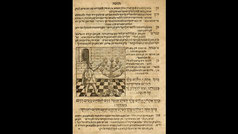
1662. Sefer Minhagim (customs)… in Ashkenaz… Amsterdam. Uri Veibesh, the woodcut illustrating the candle lighting prayers depicts the lamp which was common in the European synagogues. It is modeled on the candelabrum, tall and upright. The Menorah has seven arms and not eight or nine, as seen on later pictures (f.e. 1918). (Please see also seven-branched menorah in the Minhagim from 1593 and 1611). National Library of Israel. Source: Link1, Link2

1662. Sefer Minhagim. The lighting of the menorah. Larger illustration of the above picture with the lighting of the seven-armed Menorah. This Menorah did not show 8 arms as later pictures, but seven, as it says in the Bible. Amsterdam,Jewish National and University Library, courtesy of Beit Hatefusoth Photo Archive, Tel Aviv, Israel). Source: Link

1662. The Gold Lampstand and the Two Olive Trees of Zechariah 4:3. Title: "A Pisgah-sight of Palestine and the confines thereof: with the history of the Old and New Testament acted thereon" by Thomas Fuller (1608-1661). Also contains: Map of Canaan, Plan of Jerusalem, Map of Palestine. Beinecke Library. A record for this resource appears in Orbis, the Yale University Library catalog. Source: Link

1663. Items Used in the Construction of the Temple in Jerusalem. Title: "Philologus Hebraeo-mixtus, unà cum spicilegio philologico, continente decem quaestionum & positionum præcipuè philologico-Hebraicarum & Iudaicarum centurias. Authore Johanne Leusden ..." Author: Leusden, Johannes (1624-1699). Geographical Region: Netherlands Utrecht. Source: Link

1665. Author: Athanasius Kircher. Athanasii Kircheri e Societate Iesu Historia Eustachio-Mariana qua admiranda D. Eustachij, sociorumque vita ex varijs authoribus collecta; locus in quo eidem in monte Vulturello Christus inter cornua cerui apparuit, nouiter detectus... Source: Link1, Link2, Link3, Link4

1666. Symbola Divina et Humana Pontificum Imperatorum Regum. A cross stands in a landscape with trees and animals. In addition, a menorah and altar. A pelican feeds his boy on top of the cross. Contained in an ornament border with cartouches. The Holy Spirit in the form of a pigeon above a stream, a pedestal with a skull, two affectionate pigeons and a pair of scissors with comb. Under a pyramid with an image of lilies between the thistles. Contrib.: Sadeler, Aegidius. Link1, Link2, Link3

1667. History of the Jews: written by Flavius Joseph, translated from Greek into French. Title: "Histoire des Juifs : écrite par Flavius Joseph, sous le titre de Antiquitez judaïques, traduite sur l'original grec reveu sur divers manuscrits by Josephus, Flavius". John Adams Library (Boston Public Library), BRL; Arnauld d'Andilly, Monsieur (Robert), 1588-1674, tr; Adams, John, 1735-1826, former owner. Archive. Source: Link

1669. From the large folio French Elzevier bible. Artists and Engravers: Made by 'Nicolaes Berchem' after 'I. Elzevier'. Abraham Blooteling (1640-1690) and Jan de Visscher (1632-1692). The Elzevier publishing house was a natural choice for the publication of this new French edition of the Bible. Source: Link

1669. Menorah image in: Jewish table prayers (Original German: "Jüdische Tischgebete"). Lighting the menorah. Sultzbach, Germany. Bayerische Staatsbibliothek. Source: Link

1670. German Luther Bible. Excerpt from a large map showing the exodus of the people of Israel from Egypt. Printed in Wittenberg by Balthasar Christoph Wust. Title: "Biblia, das ist, die gantze H. Schrifft Alten und Neuen Testaments, Deutsch, D. Mart. Luthers: Sammt D. Hütteri Summarien, der Biblischen Bücher und Capitel richtiger Eintheilung, verbesserten Registern und Concordanzen..." BSB, Augsburg, Staats- und Stadtbibliothek, 4 Th B VII 27. Source: Link1, Link2

1675. History of the Old Testament, from the Sacred Scripture. Title: "Histoire de l'Ancien Testament, tirée de l'Écriture sainte." Language: French. Author: Robert Arnauld d'Andilly (1589-1674). Publisher: Le Petit (Paris). Bibliothèque nationale de France, département Philosophie, histoire, sciences de l'homme, H-5109. Source: Link

1679. Title: "La vérité à la place des ombres" (The truth instead of the shadows). At the top, gold scrolls and acanthus ornament frame a verse and medallion containing the words "the golden seven branched candelabrum of Moses in the Tabernacle." Hanging lamps and candlesticks are on either side. Below are additional verses. Golden three bar frame. French and Latin, written and illuminated in Paris for Anne Marie Louise d’Orléans, duchesse de Montpensier (1627-1693). Pierpont Morgan Library. MS M.21. Source: Link

17th century. Italy. Hanukkah lamp adorned with family emblem featuring menorah and rampant lions. Brass sheet; brass, cast; and copper rivets. Dimensions: H: 25.5; W: 26 cm. The Israel Museum, Jerusalem. Source: Link

1680 (ca.). Italian Carved and Painted Seven-Arm Forged Candelabra. This elegant, antique candelabra was created in Italy. The light has not been wired but features seven wrought iron curved arms with wood bobeches to hold candles for a dramatic effect. The turned base sits on three curved feet for stability. The rustic candelabra has its original two-tone painted finish. Measures: 39" W x 66" H. Source: Link

17th century. Hanukkah lamp. Location: Frankfurt, Germany. Technique: Silver, repoussé, cut, cast, and engraved. Artist / Creator: Schuller, Johann Valentin (16501726). The Israel Museum, Jerusalem. Source: Link

17th century. Hanukkah lamp. Location: Poland. Large standing lamps were often placed in the synagogue next to the Torah ark. The eagles (crowned or two-headed) were the emblems of the rulers of Poland, Austria, Germany, Russia. In his story “The Tale of the Menorah,” author and Nobel laureate Shmuel Y. Agnon describes a menorah similar to the ones displayed here, which belonged to the synagogue of Buczac. The town was often caught in the wars between Poland, Russia, and Austria. Israel Museum. Link

17th-18th century. Hanukkah lamp. Dimensions: Height 94 cm, Width 86 cm, Depth 45 cm. Technique: Cast brass. Item Code: ICMS-MKM-3314. Credit: Collection of the Mané-Katz Museum, Haifa, Israel. Source: Link

1680-1700. The golden candlestick displayed after various opinions. Original Dutch title: "Den gouden kandelaar na verscheide meeningen vertoond." 17th century interpretations of the menorah by Jan Luyken (1646-1712, draftsman & engraver). These illustrations of the Menorah show that Jews and Christians have tried to imagine the Menorah with 22 almond blossoms, as written in Exodus 25. Joods Historisch Museum, Amsterdam. Source: Link1, Link2

1680-1700. The candlestick and golden table from the Temple (Den Kandelaar en goude tafel uit den Tempel) by Jan Luyken (1646-1712). Seventeenth century imagination of the golden table and menorah worn as a war booty by Rome. The scene is depicted as a relief on a pedestal, on which a bust of Emperor Vespasian, and various symbols can be seen. Source: Link1, Link2
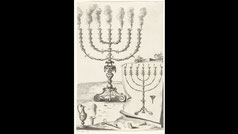
1681-1746. Print maker: François van Bleyswijck (mentioned on object). Publisher: Pieter de Hondt (possibly). Title: "Gouden zevenarmige kandelaar of menora. De marge met de titel onder de voorstelling is losgesneden van het blad." Physical features: Material: paper. Technique: etching, engraving. Measurements: h 295 mm × w 201 mm. Rijksmuseum. Source: Link1, Link2

1682. Dutch title: "Bybel Printen" (Figures of the Bible, Biblische Figuren) "Historiae sacrae Veteris et Novi Testamenti." Illustrations by Matthaeus Merian. Matthäus Merian (or "Matthew", "the Elder", 1593-1650) was a Swiss-born engraver who worked in Frankfurt (Germany) for most of his career, where he also ran a publishing house. Printed in Amsterdam (Visscher). Digitale Sammlungen der Universitätsbibliothek Erlangen-Nürnberg, Germany, Shelfmark: H62/4 SLG.RICKLEFS A 2. Source: Link

1682. Jewish Holiday Rituals. Leaf with four Jewish rites, from the second edition of Johannes van Leusden Philologus Hebraeo-Mixtus. 1. Igniting the seven-armed menorah on chanukah by a man with a long lighter in his hands. The menorah is placed on a table with a guy. 2. Five purse figures dancing and dressed under festoons, above them three smaller figures... Maker unknown. The Netherlands. Jewish Historical Museum, Amsterdam. Source: Link1, Link2, Link3

17th century. BIBLE Leviticus, Chapter 16: The Great Day of Atonement, "Capro emissary to sacrifice". Engraving from an edition of "The Bible" edited by Don Louis-Isaac Lemaistre Sacy (1613-1684), theologian, biblical scholar and humanist French. Paris, 1837. Source: Link

1683-1701. The lighting of the golden Menorah (= candlestick) in the Holy of Holies of Solomon’s Temple as portrayed by the Dutch Mennonite artist Jan Luyken (1649-1712) with original color (artist used real gold). From De republyk der Hebreen, of gemeenebest der Joden. (&) Vervolg op de drie boeken (…) uyt de naargelaten schriften van H.W. Goeree. i.e. The Hebrew Republyk, or the Jewish Commonwealth… by P. Cunaeus and published by W. Goeree/R. Blokland, in 4 volumes. Link

1683. Menorah image. Print maker: Jan Luyken, publisher: Willem Goeree; Amsterdam. Measurements: h 143 mm × w 84 mm. Luyken produced also 1705 similar pictures with little changes. Rijksmuseum. Please see also the etchings from 1705. Source: Link1, Link2, Link3, Link4, Link5, Link6, Link7, Link8, Link9, Link10

1683. Exodus. Title: La Saincte Bible, contenant le Vieil et Novveav Testament: Traduite en fran¸cois par les Theologiens de lúniversité de Louvain: avec les concordances des lieux & passages controversez de l'Ecriture Sainte". France, Paris. An engraving of 12 scenes from the book of Exodus. The scenes, from right to left as numbered, are: slavery in Egypt; Moses, Aaron, and the elders of the Israelites; the celebration of the Passover; ... alters and ritual vessels. Source: Link

1684. History of the Jews. Histoire des Juifs, ecrite ...: sous le titre de Antiquitez judaiques, Robert Arnauld d'Andilly. Translated by Robert Arnauld d'Andilly, publishing company: Chez E.H. Fricx. Original from Ohio State University. Source: Link

1684. The five books of the Torah, "Good for preparing a Sefer Torah", with Five Megillot and Haftarot. Vowelized. Venice, Italy. On the title page: an illustration of the seven-branched menorah. 15 cm. Verse numbers are handwritten. Ancient decorated leather binding. Variant. In the Bibliography of the Hebrew Book, record 0201675, a different edition is listed with Targum Onkelos [with pagination: 282, 282-329, 340-487, 489-508 leaves]. LiveAuctioneers. Source: Link

1687. German Luther Bible with a special menorah image. Title: "Biblia, Das ist: Die gantze H. Schrifft Alten und Neuen Testaments/ Deutsch/ D. Martini Lutheri ". Printed in Lüneburg. Publisher: Stern. Staatsbibliothek zu Berlin, Preußischer Kulturbesitz, Germany. Shelfmark: 2" Bu 9813. Source: Link

17th century. Map from Israel with menorah on right side. Jean-Baptiste Liébaux (16..-17..?; graveur). Map of the journey of the Israelits in the desert, from leaving Egypt until the passage of the Jordan. Source: Link

1689. The Temple and Jerusalem. Engraving by Richard Blum, London. A bird's eye view of the walled city of Jerusalem and the Temple is at the painting's center. A view of the facade of King Solomon's Temple is at the top. Surrounding this, squares depicting the vessels used in the Temple: the Ark of the Covenant, the table of showbread, the altar, the copper laver, the curtains, the menorah, the high priest in priestly garb, and the lay priest. Size: 54x42 cm, in passe-partout: 63x70 cm. Link

17th-18th century. God appears radiantly behind a black cloud as Moses swings an incense burner; four people are washing their feet and hands in preparation. Etching. Lettering: Exodus Chap. XL. The glory of God appears. Exodus 40. Verse 34. Then a cloud covered the tent of the congregation, and the glory of the Lord filled the tabernacle. Source: Link1, Link2, Link3

1695. German Images Bible. Title: "Biblia Ectypa. Bildnußen auß Heiliger Schrifft deß Alt- und Neuen Testaments, in welchen Alle Geschichte und Erscheinungen deutlich und schrifftmäßig zu Gottes Ehre und Andächtiger Seelen erbaulicher beschauung vorgestellet werden." Printed in Augsburg, Germany. Österreichische Nationalbibliothek, Austria. Source: Link

1695? Lighting the menorah / hanukiah (8 branched candlestick) at Hanukkah Drawing from 1695 Amsterdam Passover Haggadah. The second illustration was edited in color a few years ago, Credit: Lebrecht Music & Arts. Note: The illustrations from 1593, 1611 and 1662 and 1669 show a seven-armed menorah (please see above). Source: Link1, Link2

1697-1698. Illustrations from Martin's Bible (Illustraties uit de Bijbel van Martin) by Bernard Picart (1673-1733). Netherlands. Exodus XXXIX. V. 36 and 37: Golden incense altar and candlestick menorah, Copper fire altar and laver. The Ark and the Table of Showbread. Title: "Gouden reukaltaar en kandelaar, Koperen brandaltaar en wasvat." Source: Link1, Link2, Link3

1699. Luther Bible, printed in Basel (Switzerland) by Johann Brandmüllers with a strange strange appearance of the menorah. Title: "Biblia, die gantze Heilige Schrifft Alten und Neuen Testaments, verteutschet durch Doctor Martin Luther; mit lehrreichen Summarien über alle Capitul, und ordenlicher Absetzung der Versiculn, Concordantzen, Chronologey; auch underschiedlichen Registern der Historien und Hauptlehren..:" Universitätsbibliothek Basel, BibG A 76. ERARA. Source: Link1, Link2

1699. The Ark of the Covenant, the lampstand, the table with the bread of presence, and other ritual objects. German Bible. Book Title: "Biblia, die Ganze Heilige Schrift Alten und Neuen Testaments, / verteutschet durch Doctor Martin Luther..." Author: Luther, Martin (1483-1546). Source: Link

1699. German Picture Bible (Historischer Bilder-Bibel ... Theil. 2). Made in Augsburg. Writer: Johann Ulrich Kraus. Universitätsbibliothek Augsburg (Shelfmark: 221/BU 4050 K91 B5-1-5). Source: Link

17th-18th (?) century. Judaica Fragment, Judaism menorah, Jewish native art from old eastern Europe, Ukraine, Bronze Metal. Size: 67 x 34 x 20 mm. Source: Link
Menorah Pictures from other Centuries:
Until the 1st, 2nd, 3rd, 4th, 5th, 6th-10th, 11th-13th, 14th, 15th, 16th, 18th, 19th, 20th, 21st Century
Note: It's nice to see the menorah pictures. However, according to the Bible Jesus (Hebrew Yeshua) is the true spiritual meaning behind the physical Menorah. He is the true and eternal spiritual
light: "I am the light of the world. Whoever follows me will never walk in darkness, but will have the light of life" (John 8:12). The menorah also symbolizes the Tree of Life, because
Jesus is the way to life: "I am the way, and the truth, and the life. No one comes to the Father except through me" (John 14:6). Jesus' Word and the Bible are the light in this world. "Your word is a lamp to my feet and a light to my path" (Ps
119:105 and John 1:1-17).
Copyright info and disclaimer: All content and all photos from ancient and new menorahs provided on this website is for informational purposes only. It is not allowed to publish photos from this website on other websites or printed literature. Please always use only the original sources of the photos. We make no representations as to the accuracy or completeness of any information on this website or found by following any link on this website. We will not be liable for any errors or omissions in this information. We will not be liable for any losses, injuries, or damages from the display or use of this information. We can not guarantee the validity and accuracy of the information, please always check the original source. The opinions expressed from other website owners and those providing comments are theirs alone, and do not reflect the opinions of us.




